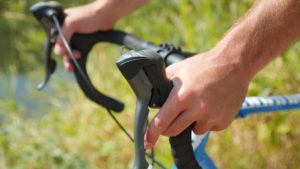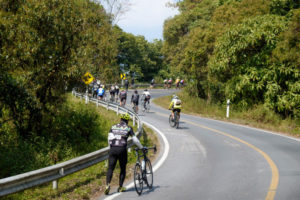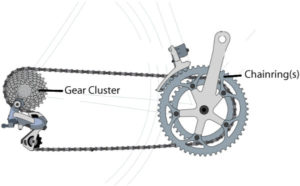If you don’t know when to shift gears on a bike, it can cause a whole lot of frustration. Those unpleasant clunks or grinding noises at the wrong moment mark that you’re struggling when you don’t need to be! You don’t just need to know how to shift your gears (although that is important), but also when. Learning to use your gears efficiently can make all the difference in your cycling progress.
Not only will knowing when to shift gears on a bike make you a faster rider, but it can also prolong the life of your chain. Here’s what you need to know about finding that perfect gear for every terrain.

What are bike gears?
Bike gears are the aspect of the drivetrain that determine the speed (cadence) at which you’re pedaling and the rate at which the drive wheel turns. Some bikes are fixed gear, so there is only one gear. However, the most common combination is three chainrings with nine gears in the back, for a total of 27 gears. These gears determine how hard (or easy) it is to pedal, and therefore dictate your speed.
How to use your gears
 If you are totally new to cycling and aren’t sure how to physically change the gears, check out our article on “How to shift gears on a bike.” This will walk you through different types of shifters, and how each system works.
If you are totally new to cycling and aren’t sure how to physically change the gears, check out our article on “How to shift gears on a bike.” This will walk you through different types of shifters, and how each system works.
The left-hand shifter or lever will control the front derailleur, guiding the chain over the chainring by your pedals. On this front end, the bigger the chainring, to more resistance you’ll have. You want to use these sparingly, keeping them for major changes in terrain.
The right-hand shifter or lever controls your rear derailleur, guiding the chain over the back gears or cogs. On these back gears, the bigger the cassette, the less resistance you’ll have. These are your fine-tuning gears that you will be using a lot more.
Using bike gears efficiently
The most common mistake beginners make is to grind away in too hard of a gear. This is not an efficient use of energy, and you’re legs will tire a lot more quickly. The general rule is to keep a steady pedal stroke that isn’t either too slow and hard, nor too easy and fast. Finding the right gear for what you’re comfortable with along with the type of terrain your riding will come with practice.
3 Benchmark Gears
- Low Gear – Also referred to as your climbing gear, low gear is the easiest the gears can be on your bike. This means your front gear is on the small chairing, and your back gear is on the largest sprocket.
- Middle Gear – This is your everyday gear for rolling terrain. There is enough resistance so you can cruise at a modest speed, but not too much as to slow down your cadence too much. This means being on the small chainring on a double or a compact, and the middle chainring on a triple. The back gear will be hovering around the middle sprockets, adjusted according to any changes in terrain.
- High Gear – This is for the fun parts. This will keep your legs spinning and the bike accelerating as you descend, or for pushing yourself as fast as you can on flats. The front gear will be on the big chainring, and the back will be on the smallest sprocket.
Don’t Cross the Chain
Avoid using the large front chainring simultaneously as the largest rear sprocket as this can cause your chain to slip or not shift properly. This is referred to as “crossing the chain.” Try running through the majority of your  rear gears before touching your front chainrings.
rear gears before touching your front chainrings.
The first step towards using your gears efficiently is to take a look at your cadence. Once you get a feel for what a proper cadence range feels like, you will start to pick gears that will keep you within that. Keep your eyes ahead on the road so you have plenty of time to shift down before you hit a hill. If you don’t, you may not be able to shift gears in time and you’ll end up having to walk your bike.
Learning how and when to shift gears on a bike is one of those things that you learn when starting to ride and as you ride more, you will get good at it. Just make sure to practice in a safe area, say an empty parking lot or driveway, as your focus will be on the shifting, not and traffic or other hazards that may be around.
